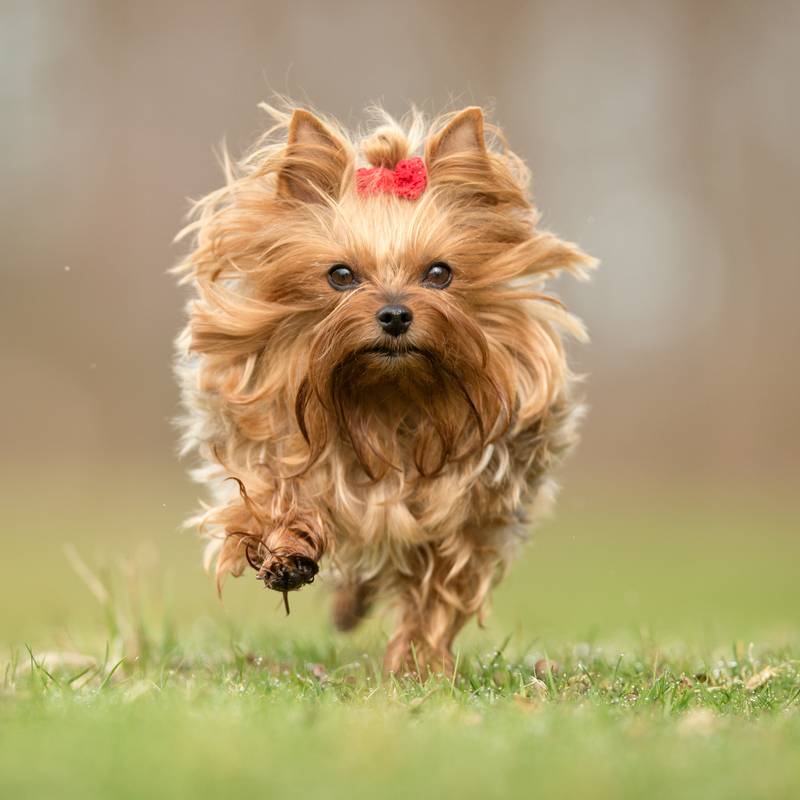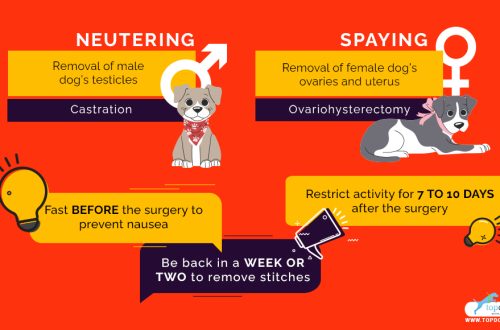
Frequent diseases of dwarf dog breeds
The list of diseases, hereditary and acquired, is very wide. Often babies suffer from congenital dislocation of the patella, eye diseases, diabetes or dermatitis. Let’s take a closer look at some diseases.
Contents
Dislocation of the patella
This disease is the most common congenital anomaly in toy breeds. Dislocations of the patella are divided into congenital (genetically inherited) and acquired (traumatic). More often in dwarf breeds, the patella comes out inward from the knee block (medial). It is unilateral or bilateral.
The clinical signs associated with patella luxation vary greatly depending on the severity of the disease. Patellar luxation is diagnosed on the basis of an orthopedic examination and is confirmed by X-ray examination of the extremities. According to the degree of damage, based on the orthopedic examination, the dislocation of the patella is assessed on a scale from 0 to 4. In the early stages of the manifestation of the disease, it is possible to use conservative therapy, physiotherapy (swimming), body weight control is necessary.
For animals with the second and higher degree of development of dislocation, surgical intervention is indicated. Which should be carried out as early as possible to preserve the function of the joint and prevent the early development of arthritis and arthrosis.
Pathologies of the musculoskeletal system are detected already during the initial vaccination, and a general practitioner or therapist sends you to a veterinary orthopedist.

Eye diseases
Cataracts, entropion (eyelid torsion), corneal dystrophy, glaucoma, juvenile cataract, progressive retinal atrophy, blepharospasm, tear duct obstruction – this is an incomplete list of eye diseases that dwarf breeds are susceptible to. These are often hereditary diseases caused by unscrupulous breeding of dogs, based not on the principles of selection, but on commercial gain. So, in breeds with a once mesocephalic structure of the skull, a brachycephalic syndrome develops due to the so-called “baby face”. The planting of the eyes, the anatomy of the eyelids and the muscles of the facial skull also changed. It is important to know how the eyes of a healthy animal should look in order to notice the pathology in time and contact a veterinary ophthalmologist. The conjunctiva should be moist, pale pink in color, and the surface of the eye should be even and shiny. Discharge from the eyes should not normally be, or they will be slight and transparent.
Healthy eyelids should fit snugly against the eyeball and slide freely over its surface. In this case, the dog is easily oriented in the surrounding space at any time of the day. Yorkshire Terriers have genetic tests to determine some of these.
Hydrocephalus
A congenital disease characterized by excessive formation and accumulation of cerebrospinal fluid in the cerebral ventricles. At the same time, the total volume of the brain remains unchanged, therefore, due to the increase in pressure in the cerebral ventricles, the amount of nervous tissue decreases. This leads to severe manifestations of the disease. The development of this disease is predisposed to a mismatch in the size of the brain and cranium, as well as a violation of the liquor flow due to Chiari syndrome. The most susceptible to this disease are dwarf breeds of dogs. Hydrocephalus is evidenced by the characteristic appearance of the dog, which distinguishes it from littermates. The main features are a very large skull on a thin neck; strabismus (strabismus of the eyeballs); behavioral disorders (aggressiveness, bulimia, increased libido, difficulties in training).
Neurological disorders (moving in a circle, tilting the head back or tilting to one side). If you notice any oddities in your pet, seek the advice of a veterinary neurologist, this can save the dog’s life.

Cryptorchidism
This is a hereditary anomaly in which the testis does not enter the scrotum in a timely manner. Normally, this happens on the 14th day, in some breeds it can take up to 6 months. Cryptorchidism is much more common in small breed dogs than in large breeds. The probability of cryptorchidism in dogs is 1,2-10% (depending on the breed). Most often, cryptorchidism is observed in poodles, Pomeranians, Yorkshire terriers, Chihuahuas, Maltese lapdogs, toy terriers. Such males are subject to castration and are culled from breeding.
Periodontitis
A serious inflammatory disease of the oral cavity, which, when progressing, can affect the bone tissue surrounding and supporting the teeth. Small breed dogs are the most frequent patients at the veterinary dentist. In dogs of these breeds, the resulting plaque quickly mineralizes, turning into tartar. It is believed that the saliva of dogs of dwarf breeds differs from the saliva of other dogs in mineral composition. They have a faster process of mineralization of plaque.
In addition, several factors contribute to this. In toy breed dogs, the teeth are large in relation to the size of the jaws. The distance between the teeth is smaller than in “normal” sized dogs. There is no chewing load (unwillingness of the dog to gnaw). Frequent eating – it is not uncommon for small dogs to have food in the bowl all day, and the dog eats a little bit all day. Moist soft food also affects. To home care for the oral cavity of a puppy, you need to start accustoming it as soon as it enters your family. The first professional sanitation of the oral cavity by a veterinary dentist is carried out no later than 2 years.

Collapse of the trachea
A genetically determined chronic degenerative disease associated with anatomical deformity of the tracheal rings. Due to the flattening of the trachea, the lumen acquires a crescent shape. This leads to the inevitable contact and friction of the upper and lower walls of the trachea, which is clinically manifested by a cough of varying severity, up to suffocation and death. Factors provoking the development of the clinical picture of tracheal collapse include obesity, respiratory infections, an increased concentration of irritants in the air (cigarette smoke, dust, etc.).
Most often, this disease is diagnosed in representatives of dwarf breeds of dogs. The reason for this may be a congenital defect of the cartilage of the larynx and trachea, as well as long-term, chronic inflammatory diseases of the respiratory tract, edema associated with allergic reactions, injuries, foreign bodies, tumors, heart disease, endocrine diseases.
Such pets need a comprehensive examination. This is primarily necessary to identify the presence and degree of development of pathology. Respiratory failure can be both a cause and a consequence of tracheal collapse. Diagnostics consists of both routine examinations (blood tests, urine tests, ultrasound) and visual diagnostics (X-ray, tracheobronchoscopy). The earlier such a diagnosis is made, the less surprises you will receive from your pet. Therefore, if the dog makes extraneous sounds when breathing, suffocates in anger or at a joyful meeting, and possibly in moments of fright, you should immediately contact the clinic for an examination.
Brachycephalic Syndrome
The syndrome includes stenosis of the nostrils, enlargement and thickening of the soft palate, eversion of the laryngeal sacs, and collapse of the larynx. The symptoms are easily confused with the previous disease, but brachycephalic syndrome is amenable to surgical treatment with very good postoperative statistics. The main thing is to operate as soon as possible.

You cannot recommend choosing a friend based on dry statistics and a list of possible problems, because there are no completely healthy dog breeds. But when choosing a pet for yourself, you should know what you will encounter and prevent all possible problems as much as possible.
Diseases of some breeds
Australian silky terrier: Legg-Calve-Perthers disease, patellar luxation, diabetes mellitus, tracheal collapse, susceptibility to dermatitis and thyroid dysfunction.
Bichon Frize: epilepsy, urolithiasis, diabetes mellitus, hypotrichosis (hair loss), atlanto-axial instability, patellar luxation, dermatitis, tendency to allergic reactions, cataract, entropion, corneal dystrophy.
Bolognese (Italian lap dog): tendency to dermatitis, violation of the change of teeth, periodontitis.
Italian Greyhound (Italian Greyhound): cataract, progressive retinal atrophy, glaucoma, corneal dystrophy, juvenile cataract, epilepsy, Legg-Calve-Perthers disease, patellar luxation, periodontitis, alopecia, cryptorchidism, color mutational alopecia.
Yorkshire Terrier: anomalies in the development of the bones of the skull, cryptorchidism, dislocation of the patella, Legg-Calve-Perters disease, tracheal collapse, impaired change of teeth, periodontitis, distichiasis, hypoglycemia; portosystemic shunts, deformity of the heart valves, atlanto-axial instability, allergic skin diseases, dermatoses, dermatitis, hydrocephalus, conjunctivitis, cataracts, blepharospasm, urolithiasis, increased reaction to medications, drugs.
MalteseKey words: glaucoma, occlusion of the lacrimal ducts, retinal atrophy and distichiasis, tendency to dermatitis, tendency to deafness, hydrocephalus, hypoglycemia, heart defects, congenital subluxation of the patella, pyloric stenosis, cryptorchidism, portosystemic shunts.
Papillon (Continental Toy Spaniel): entropy, cataract, corneal dystrophy, deafness, patellar luxation, follicular dysplasia.
Pomeranian Spitz: atlanto-axial instability, patellar luxation, hypothyroidism, cryptorchidism, tracheal collapse, sinus node weakness syndrome, congenital dislocation of the elbow joint, cataract, entropion, progressive retinal atrophy, epilepsy, dwarfism, abnormalities in the formation of skull bones, hydrocephalus.
Russian toy terrier: dislocation of the patella, cataract, progressive retinal atrophy, hydrocephalus, periodontitis, impaired change of teeth.
Chihuahua: hydrocephalus, periodontitis, pulmonary stenosis, retinal atrophy, luxation of the patella, cryptorchidism, tracheal collapse, mitral valve dysplasia, hypoglycemia, dwarfism, abnormalities in the formation of skull bones.
Japanese Hin (Chin, Japanese Spaniel): patella luxation, cataract, brachycephalic syndrome, hypothyroidism, mitral valve stenosis, iris erosion, distichiasis, progressive retinal atrophy, vitreoretinal dysplasia, cryptorchidism, dwarfism, hemivertebra, hip dysplasia, atlanto-axial instability, dislocation of the elbow joint, dislocation of the patella, achondroplasia, epilepsy.
Petersburg orchid: hydrocephalus, violation of the change of teeth, periodontitis, epilepsy, Legg-Calve-Perthers disease, dislocation of the patella.
Toy fox terrier: spinocerebellar ataxia with myokymia and / or convulsions, periodontitis, cryptorchidism.





